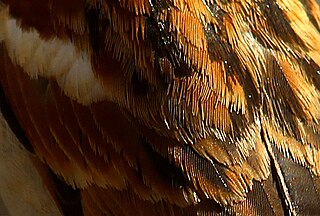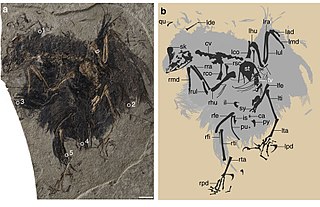
The Aleuts, who are usually known in the Aleut language by the endonyms Unangan, Unangas, Унаӈан, are the indigenous people of the Aleutian Islands.

An arrow is a fin-stabilized projectile launched by a bow. A typical arrow usually consists of a long, stiff, straight shaft with a weighty arrowhead attached to the front end, multiple fin-like stabilizers called fletchings mounted near the rear, and a slot at the rear end called nock for engaging the bowstring. A container or bag carrying additional arrows for convenient reloading is called a quiver.

Falconry is the hunting of wild animals in their natural state and habitat by means of a trained bird of prey. Small animals are hunted; squirrels and rabbits often fall prey to these birds. Two traditional terms are used to describe a person involved in falconry: a "falconer" flies a falcon; an "austringer" flies a hawk or an eagle. In modern falconry, the red-tailed hawk, Harris's hawk, and the peregrine falcon are some of the more commonly used birds of prey. The practice of hunting with a conditioned falconry bird is also called "hawking" or "gamehawking", although the words hawking and hawker have become used so much to refer to petty traveling traders, that the terms "falconer" and "falconry" now apply to most use of trained birds of prey to catch game. Many contemporary practitioners still use these words in their original meaning, however.

The red-winged blackbird is a passerine bird of the family Icteridae found in most of North America and much of Central America. It breeds from Alaska and Newfoundland south to Florida, the Gulf of Mexico, Mexico, and Guatemala, with isolated populations in western El Salvador, northwestern Honduras, and northwestern Costa Rica. It may winter as far north as Pennsylvania and British Columbia, but northern populations are generally migratory, moving south to Mexico and the southern United States. Claims have been made that it is the most abundant living land bird in North America, as bird-counting censuses of wintering red-winged blackbirds sometimes show that loose flocks can number in excess of a million birds per flock and the full number of breeding pairs across North and Central America may exceed 250 million in peak years. It also ranks among the best-studied wild bird species in the world. The red-winged blackbird is sexually dimorphic; the male is all black with a red shoulder and yellow wing bar, while the female is a nondescript dark brown. Seeds and insects make up the bulk of the red-winged blackbird's diet.

Wing clipping is the process of trimming a bird's primary wing feathers or remiges so that it is not fully flight-capable, until it moults, sheds the cut feathers and grows new ones.

In biology, moulting, or molting, also known as sloughing, shedding, or in many invertebrates, ecdysis, is the manner in which an animal routinely casts off a part of its body, either at specific times of the year, or at specific points in its life cycle.

A pin feather is a developing feather on a bird. This feather can grow as a new feather during the bird's infancy, or grow to replace one from moulting.

Anting is a maintenance behaviour during which birds rub insects, usually ants, on their feathers and skin. The bird may pick up the insects in its bill and rub them on the body, or the bird may lie in an area of high density of the insects and perform dust bathing-like movements. The insects secrete liquids containing chemicals such as formic acid, which can act as an insecticide, miticide, fungicide, or bactericide. Alternatively, anting could make the insects edible by removing the distasteful acid, or, possibly supplement the bird's own preen oil. Instead of ants, birds can also use millipedes. More than 200 species of bird are known to ant. A possibly related behaviour, self-anointing, is seen in many mammals.

Plumage is a layer of feathers that cover a bird and the pattern, colour, and arrangement of those feathers. The pattern and colours of plumage differ between species and subspecies and may vary with age classes. Within species, there can be different colour morphs. The placement of feathers on a bird is not haphazard, but rather emerge in organized, overlapping rows and groups, and these feather tracts are known by standardized names.

The down of birds is a layer of fine feathers found under the tougher exterior feathers. Very young birds are clad only in down. Powder down is a specialized type of down found only in a few groups of birds. Down is a fine thermal insulator and padding, used in goods such as jackets, bedding (duvets), pillows and sleeping bags. The discovery of feathers trapped in ancient amber suggests that some species of dinosaur may have possessed down-like feathers.

The prairie falcon is a medium-large sized falcon of western North America. It is about the size of a peregrine falcon or a crow, with an average length of 40 cm (16 in), wingspan of approximately 1 meter (40 in), and average weight of 720 g (1.6 lb). As in all falcons, females are noticeably bigger than males. Though a separate species from the peregrine, the prairie falcon is basically an arid environment adaptation of the early peregrine falcon lineage, able to subsist on less food than the peregrine, and generally lighter in weight than a peregrine of similar wing span. Having evolved in a harsh desert environment with low prey density, the prairie falcon has developed into an aggressive and opportunistic hunter of a wide range of both mammal and bird prey. It will regularly take prey from the size of sparrows to approximately its own weight, and occasionally much larger. It is the only larger falcon native only to North America. It is resident from southern Canada, through western United States, and into northern Mexico. The prairie falcon is popular as a falconry bird, where with proper training it is regarded as being as effective as the more well known peregrine falcon.
Raptor rehabilitation is a field of veterinary medicine dealing with care for sick or injured birds of prey, with the goal of returning them to the wild. Since raptors are highly specialized predatory birds, special skills, facilities, equipment, veterinary practices and husbandry methods are necessary.
Training raptors is a complex undertaking. Books containing advice by experienced falconers are still rudimentary at best. Many important details vary between individual raptors, species of raptors and between places and times. The keeping and training of any raptor is strictly and tightly regulated by U.S. state and federal laws. Anyone in the USA who is interested in flying raptors must seek out a state and federally licensed falconer to sponsor them through an apprenticeship period lasting two years at a minimum, and often considerably longer.

The following outline is provided as an overview of and topical guide to birds:
The Abu Dhabi Falcon Hospital (ADFH) is the first public medical institution exclusively for falcons in the United Arab Emirates. Established by Environment Agency – Abu Dhabi and opened on 3 October 1999, Abu Dhabi Falcon Hospital has become the largest falcon hospital in the UAE and in the world with a patient influx of approximately 11,000 falcons per year. The ADFH describes their mission as a goal "To protect, conserve, research, and promote captive-bred and wild falcons health, wildlife, and falconry tradition. To lead efforts of Abu Dhabi government to improve and protect animal welfare and to increase awareness and responsibility of people for animal welfare as the leading center for animal healthcare and welfare in Abu Dhabi Emirate."

The conservation and restoration of feathers is the practice of maintaining and preserving feathers or featherwork objects, and requires knowledge of feather anatomy, properties, specialized care procedures, and environmental influences. This practice may be approached through preventive and/or interventive techniques.

Mankind has been fascinated by the golden eagle as early as the beginning of recorded history. Most early-recorded cultures regarded the golden eagle with reverence. Only after the Industrial Revolution, when sport-hunting became widespread and commercial stock farming became internationally common, did humans started to widely regard golden eagles as a threat to their livelihoods. This period also brought about the firearm and industrialized poisons, which made it easy for humans to kill the evasive and powerful birds. The following are various reportages of the significance of eagles, many likely pertaining to the golden eagles, in early cultures and older religions as well as national and military insignias.
Feather development occurs in the epidermal layer of the skin in birds. It is a complicated process involving many steps. Once the feathers are fully developed, there are six different types of feathers: contour, flight, down, filoplumes, semiplumes, and bristle feathers. Feathers were not originally meant for flight. The exact reason why feathers evolved is still unknown. Birds are thought to be descendants of dinosaurs and new technology using melanosomes found in dinosaur fossils has shown that certain dinosaurs that could not fly had feathers.

The following is a glossary of common English language terms used in the description of birds—warm-blooded vertebrates of the class Aves and the only living dinosaurs, characterized by feathers, the ability to fly in all but the approximately 60 extant species of flightless birds, toothless, beakedjaws, the laying of hard-shelled eggs, a high metabolic rate, a four-chambered heart and a strong yet lightweight skeleton.

Cruralispennia is an extinct genus of enantiornithean bird. The only known specimen of Cruralispennia was discovered in the Early Cretaceous Huajiying Formation of China and formally described in 2017. The type species of Cruralispennia is Cruralispennia multidonta. The generic name is Latin for "shin feather", while the specific name means "many-toothed". The holotype of Cruralispennia is IVPP 21711, a semi-articulated partial skeleton surrounded by the remains of carbonized feathers.
















